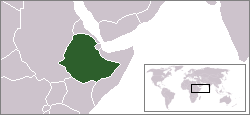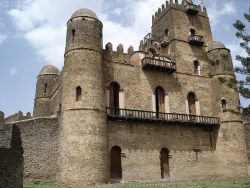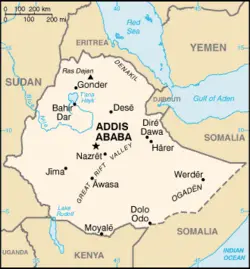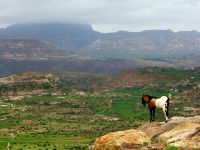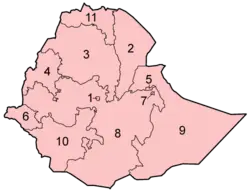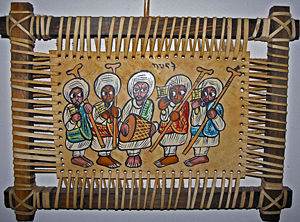Ethiopia
THIS ARTICLE IS CLAIMED FOR VICKI PHELPS BY MARY ANGLIN - APRIL 11, 2007.
| የኢትዮጵያ ፌዴራላዊ ዲሞክራሲያዊ ሪፐብሊክ ye-Ītyōṗṗyā Fēdēralāwī Dīmōkrāsīyāwī Rīpeblīk Federal Democratic Republic of Ethiopia |
||||||
|---|---|---|---|---|---|---|
|
||||||
| Motto: none | ||||||
| Anthem: Wodefit Gesgeshi, Widd Innat Ityopp'ya (March Forward, Dear Mother Ethiopia) |
||||||
| Capital (and largest city) | Addis Ababa 9°01′N 38°44′E | |||||
| Official languages | Amharic | |||||
| Government | Federal republic1 | |||||
| - | President | Girma Wolde-Giorgis | ||||
| - | Prime Minister | Meles Zenawi | ||||
| Independence | ||||||
| - | Liberation Day | N.A. | ||||
| Area | ||||||
| - | Total | 1,104,300 km² (26th) 426,371 sq mi |
||||
| - | Water (%) | 0.7% | ||||
| Population | ||||||
| - | 2006 estimate | 75,067,000 (15th2) | ||||
| - | 1994 census | 53,477,265 | ||||
| GDP (PPP) | 2005 estimate | |||||
| - | Total | $59,930,000,000 (69th) | ||||
| - | Per capita | $800 (173rd) | ||||
| Currency | Birr (ETB) |
|||||
| Time zone | (UTC+3) | |||||
| - | Summer (DST) | (UTC+4) | ||||
| Internet TLD | .et | |||||
| Calling code | +251 | |||||
| 1Ethiopia is ostensibly a democracy, but has a dominant-party system led by the Ethiopian People's Revolutionary Democratic Front. 2Rank based on 2005 population estimate by the United Nations |
||||||
Ethiopia, officially the Federal Democratic Republic of Ethiopia (Ge'ez ኢትዮጵያ Ītyōṗṗyā), is a country situated in the Horn of Africa. It is bordered by Eritrea to the north, Djibouti to the northeast, Somalia to the east, Kenya to the south, and Sudan to the west. It has one of the most extensive known histories as an independent nation on the continent, or indeed in the world and is also known for being one of the founders of the United Nations. Unique among African countries, Ethiopia maintained independence during the Scramble for Africa, and continued to do so except for a five-year period (1936-41) when it was under Italian occupation. But even during this period there was no Italian colonization of Ethiopia as the Italians occupied a few key cities and most of Ethiopia was not affected by their presence; the Italian period is thus considered an "occupation" and not colonial rule.
Ethiopia was also historically called Abyssinia, derived from the Arabic form of the Ethiosemitic name "HBSHT," modern Habesha. The English name "Ethiopia" is thought to be derived from the Greek word Αἰθιοπία Aithiopia, from Αἰθίοψ Aithiops ‘an Ethiopian’, derived from Greek terms meaning "of burnt (αιθ-) visage (ὄψ)".[1] However, this etymology is disputed. The Book of Aksum, an Ge'ez chronicle first composed in the 15th century, states that the name is derived from "'Ityopp'is", a son (unmentioned in the Bible) of Cush, son of Ham who according to legend founded the city of Axum.
History
The Kingdom of Aksum, the first verifiable kingdom of great power to rise in Ethiopia, rose during the first century B.C.E. The Persian religious figure Mani listed Axum with Rome, Persia, and China as one of the four great powers of his time.[2] It was in the early 4th century AD that a Syro-Greek castaway, Frumentius, was taken to the court and eventually converted king Ezana to Christianity, thereby making it official.[3] For this accomplishment, he received the title "Abba Selama" ("Father of peace"). At various times, including a period in the 6th century, Axum controlled most of modern-day Yemen and some of southern Saudi Arabia just across the Red Sea, as well as controlling northern Sudan, northern Ethiopia, Eritrea, Djibouti, and northern Somalia.[4]
The line of rulers descended from the Axumite kings was broken several times: first by the Jewish or pagan Queen Gudit around 950[5] or 850.[6] It was then interrupted by the Zagwe dynasty; it was during this dynasty that the famous rock-hewn churches of Lalibela were carved under King Lalibela, allowed by a long period of peace and stability.[7] Around 1270, the Solomonid dynasty came to control Ethiopia, claiming descent from the kings of Axum. They called themselves Neguse Negest ("King of Kings," or Emperor), basing their claims on their direct descent from Solomon and the queen of Sheba.[8]
During the reign of Emperor Yeshaq, Ethiopia made its first successful diplomatic contact with a European country, sending two emmisaries to Alfons V of Aragon, who sent return emissaries that failed to complete the trip to Ethiopia.[9] The first continuous relations with a European country began in 1508 with Portugal under Emperor Lebna Dengel, who had just inherited the throne from his father.[10] This proved to be an important development, for when the Empire was subjected to the attacks of the Adal General and Imam, Ahmad ibn Ibrihim al-Ghazi (called "Grañ", or "the Left-handed"), Portugal responded to Lebna Dengel's plea for help with an army of 400 men, who helped his son Gelawdewos defeat Ahmad and re-establish his rule.[11]. However, when Emperor Susenyos converted to Roman Catholicism in 1624, years of revolt and civil unrest followed resulting in thousands of deaths.[12] The Jesuit missionaries had offended the Orthodox faith of the local Ethiopians, and on June 25, 1632 Susenyos' son, Emperor Fasilides, declared the state religion to again be Ethiopian Orthodox Christianity, and expelled the Jesuit missionaries and other Europeans. [13][14]
All of this contributed to Ethiopia's isolation from 1755 to 1855, called the Zemene Mesafint or "Age of Princes." The Emperors became figureheads, controlled by warlords like Ras Mikael Sehul of Tigray, and later by the Oromo Yejju dynasty.[15] Ethiopian isolationism ended following a British mission that concluded an alliance between the two nations; however, it was not until the reign of Emperor Tewodros II, who began modernizing Ethiopia and recentralizing power in the Emperor, that Ethiopia began to take part in world affairs once again.
The 1880s were marked by the Scramble for Africa and modernization in Ethiopia, when the Italians began to vie with the British for influence in bordering regions. Assab, a port near the southern entrance of the Red Sea, was bought from the local Afar sultan, vassal to the Ethiopian Emperor, in March 1870 by an Italian company, which by 1890 led to the Italian colony of Eritrea. Conflicts between the two countries resulted in the Battle of Adowa in 1896, whereby the Ethiopians surprised the world by defeating the colonial power and remaining independent, under the rule of Menelik II. Italy and Ethiopia signed a provisional treaty of peace on October 26 1896.
The early 20th century was marked by the reign of Emperor Haile Selassie I, who undertook the rapid modernization of Ethiopia — interrupted only by the brief Italian occupation (1936–1941).[16] British and patriot Ethiopian troops liberated the Ethiopian homeland in 1941, which was followed by sovereignty on January 31, 1941 and British recognition of full sovereignty (i.e. without any special British privileges) with the signing of the Anglo-Ethiopian Agreement in December 1944.[17]
Haile Selassie's reign came to an end in 1974, when a pro-Soviet Marxist-Leninist military junta, the "Derg", deposed him and established a one-party communist state. The ensuing regime suffered several bloody coups, uprisings, wide-scale drought, and a massive refugee problem. In 1977 Somalia attacked Ethiopia in the Ogaden War, but Ethiopia quickly defeated them with a massive influx of Soviet military hardware, direct Cuban military presence, coupled with East German and South Yemeni military assistance the following year. In spite of accruing one of the largest armies in Africa due to benevolent military assistance from Socialist Bloc countries, an unending insurgency in the then provinces of Eritrea and Tigray, a major drought in 1985 and regime changes in the former Socialist Bloc culminated in the Derg regime being defeated in 1991 by the Eritrean People's Liberation Front (EPLF) in the far north, and elsewhere by the Ethiopian Peoples' Revolutionary Democratic Front (EPRDF), a loose coalition of rebel forces mainly dominated by the Tigrean People's Liberation Front. In 1993, the province of Eritrea became independent from Ethiopia, following a referendum, ending more than 20 years of armed conflict, one of the longest in Africa. In 1994, a constitution was adopted, that led to Ethiopia's first multiparty elections in the following year. In May 1998, a dispute over the undemarcated border with Eritrea led to the Eritrean-Ethiopian War that lasted until June 2000. This has hurt the nation's economy, but strengthened the ruling coalition. On May 15, 2005, Ethiopia held another multiparty election, and resulted in the EPRDF's disputed return to power. In early June and again in November, police under the command of the EPRDF shot and killed demonstrators who were protesting the alleged election fraud.
Politics
The election of Ethiopia's 547-member constituent assembly was held in June 1994. This assembly adopted the constitution of the Federal Democratic Republic of Ethiopia in December 1994. The elections for Ethiopia's first popularly-chosen national parliament and regional legislatures were held in May and June 1995. Most opposition parties chose to boycott these elections. There was a landslide victory for the Ethiopian People's Revolutionary Democratic Front (EPRDF). International and non-governmental observers concluded that opposition parties would have been able to participate had they chosen to do so.
The Government of the Federal Democratic Republic of Ethiopia was installed in August 1995. The first President was Negasso Gidada. The EPRDF-led government of Prime Minister Meles Zenawi has promoted a policy of ethnic federalism, devolving significant powers to regional, ethnically-based authorities. Ethiopia today has 9 semi-autonomous administrative regions that have the power to raise and spend their own revenues. Under the present government, Ethiopians enjoy greater political participation and freer debate than ever before in their history, although some fundamental freedoms, including freedom of the press, are, in practice, somewhat circumscribed.
Zenawi's government was re-elected in 2000 in Ethiopia's first multi-party elections. The incumbent President is Girma Wolde-Giorgis.
Since 1991, Ethiopia has established warm relations with the United States and western Europe and has sought substantial economic aid from Western countries and World Bank. In 2004, the government began a drive to move more than two million people away from the arid highlands of the east, proposing that these resettlements would reduce food shortages [18].
Ethiopia held another general election in May 2005, which drew a record number of voters, with 90% of the electorate turning out to cast their vote. While the election was deemed by the European Union election observer team to fall short of international standards for fair and free elections, other teams drew different conclusions. The African Union report on September 14 commended "the Ethiopian people's display of genuine commitment to democratic ideals", and on September 15 the US Carter Center concluded that "the majority of the constituency results based on the May 15 polling and tabulation are credible and reflect competitive conditions". The US Department of State said on September 16, "these elections stand out as a milestone in creating a new, more competitive multi-party political system in one of Africa's largest and most important countries." Even the EU preliminary statement of 2005 also said "...the polling processes were generally positive. The overall assessment of the process has been rated as good in 64% of the cases, and very good in 24%".
The opposition complained that the ruling EPRDF engaged in widespread vote rigging and intimidation, alleging fraud in 299 constituencies. All allegations were investigated by the National Electoral Board of Ethiopia in cooperation with election monitors, a process which delayed the release of the final results. In June 2005, with the results of the election still unclear, a group of university students protested these alleged discrepancies, encouraged by supporters of the Coalition for Unity opposition party, despite a ban on protests imposed by the government. On June 8, 26 people were killed in Addis Ababa as a result of rioting, which led to the arrest of hundreds of protesters. On September 5, 2005, the National Elections Board of Ethiopia released the final election results in which confirmed that the ruling Ethiopian People's Revolutionary Democratic Front retained its control of the government, but showed that opposition parties had increased their share of parliamentary seats, from 12 to 176. The Coalition for Unity and Democracy won all the seats in Addis Ababa, both for the Parliament and the City Council.
Street protests broke out again, when the opposition called for a general strike and boycotted the new Parliament, refusing to accept the results of the election. The police forces once again attempted to contain the protests and this time 42 people were killed in Addis Ababa, including seven policemen, and another of whom later died because of fatal injuries caused by a hand grenade detonation. Thousands were arrested, and were taken to various detention centers across the country. By February 2006, six hundred remained in custody, facing trial in March.
On 14 November, the Ethiopian Parliament passed a resolution to establish a neutral commission to investigate the incidents of June 8 and November 1 and 2. In February 2006, UK Prime Minister Blair, acknowledging that the EPRDF has won the election, said he wanted to see Ethiopia resolve its internal problems and continue on a democratic path [19].
Geography
Ethiopia is 1,127,127 square kilometres (435,071 sq. mi) in size, and is the major portion of the Horn of Africa, which is the eastern-most part of the African landmass. Bordering Ethiopia is Sudan to the west, Djibouti and Eritrea to the north, Somalia to the east, and Kenya to the south. Within Ethiopia is a massive highland complex of mountains and dissected plateaus divided by the Great Rift Valley, which runs generally southwest to northeast and is surrounded by lowlands, steppes, or semi-desert. The great diversity of terrain determines wide variations in climate, soils, natural vegetation, and settlement patterns.
Climate and ecology
Elevation and geographic location produce three climatic zones: the cool zone above 2,400 meters (7,900 ft) where temperatures range from near freezing to 16°C (32°–61°F); the temperate zone at elevations of 1,500 to 2,400 meters (4,900—7,900 ft) with temperatures from 16°C to 30°C (61°–86°F); and the hot zone below 1,500 meters (4,900 ft) with both tropical and arid conditions and daytime temperatures ranging from 27°C to 50°C (81°–122°F). The normal rainy season is from mid-June to mid-September (longer in the southern highlands) preceded by intermittent showers from February or March; the remainder of the year is generally dry.
Ethiopia is an ecologically diverse country. Lake Tana in the north is the source of the Blue Nile. It also has a large number of endemic species, notably the Gelada Baboon, the Walia Ibex and the Ethiopian wolf (or Simien fox).
Administrative divisions
Before 1996 Ethiopia was divided into 13 (14 before Eritrea's independence in 1993) provinces, many of which historical bases. Ethiopia now has a tiered government system consisting of a federal government, ethnically-based regional states, zones, woredas (districts), and kebeles (neighborhoods).
There are 9 ethnically-based administrative regions kililoch; singular: kilil), and subdivided into 68 zones,two chartered cities (astedader akababiwoch, singular: astedader akababi): Addis Ababa and Dire Dawa(respectively, subdivisions 1 and 5 in the map), 550 woredas and six special woredas.
The constitution assigns extensive power to regional states that can establish their own government and democracy according to the federal government's constitution. Each region has its appex regional council where members are directly elected to represent the districts and the council has legislative and excutive power to direct internal affairs of the regions. Article 39 of the Ethiopian Constitution further gives every regional state the right to secede from Ethiopia. There is debate, however, as to how much of the power guaranteed in the constitution is actually given to the states.
The councils implement their mandate through an executive committee and regional sectoral bureaus. Such elaborate structure of council,executive and sectoral public institutions is replicated to woreda (district) levels.
The subdivisions of Ethiopia are:
- Addis Ababa (chartered city)
- Afar
- Amhara
- Benishangul-Gumaz
- Dire Dawa (chartered city)
- Gambela
- Harari
- Oromia
- Somali
- Southern Nations, Nationalities, and Peoples Region
- Tigray
Economy
Main article: Economy of Ethiopia
Ethiopia remains one of Africa's poorest nations; many Ethiopians rely on food aid from abroad.
After the 1974 revolution, the economy of Ethiopia was run as a socialist economy: strong state controls were implemented, and a large part of the economy was transferred to the public sector, including most modern industry and large-scale commercial agriculture, all agricultural land and urban rental property, and all financial institutions. Since mid-1991, the economy has evolved toward a decentralized, market-oriented economy, emphasizing individual initiative, designed to reverse a decade of economic decline. In 1993, gradual privatization of business, industry, banking, agriculture, trade, and commerce was underway.
Nevertheless, Ethiopia is not fully privatized. The ruling EPRDF controls more than fifty large business enterprises in Ethiopia, following the Chinese model. Some of the enterprises are Ambasel, Guna, Tikur Abay, Dinsho, Mega, etc. Many government owned properties during the previous regime have now been transferred to these EPRDF owned enterprises in the name of privatization. Furthermore, the Ethiopian constitution defines the right to own land as belonging only to "the state and the people," but citizens may only lease land (up to 99 years), unable to mortgage, sell, or own it.[2]
Agriculture accounts for almost 41 percent of the gross domestic product (GDP), 80 percent of exports, and 80 percent of the labor force. Many other economic activities depend on agriculture, including marketing, processing, and export of agricultural products. Production is overwhelmingly of a subsistence nature, and a large part of commodity exports are provided by the small agricultural cash-crop sector. Principal crops include coffee, pulses (e.g., beans), oilseeds, cereals, potatoes, sugarcane, and vegetables. Exports are almost entirely agricultural commodities, and coffee is the largest foreign exchange earner. Ethiopia's livestock population is believed to be the largest in Africa, and as of 1987 accounted for about 15 percent of the GDP.
Demographics
Ethiopia's population is highly diverse. Most of its people speak a Semitic or Cushitic language. The Oromo, Amhara, and Tigrayans make up more than three-fourths of the population, but there are more than 80 different ethnic groups within Ethiopia. Some of these have as few as 10,000 members.
Semitic-speaking Ethiopians and Eritreans collectively refer to themselves as Habesha or Abesha, though others reject these names on the basis that they refer only to certain ethnicities [20]. The Arabic form of this term is the etymological basis of "Abyssinia," the former name of Ethiopia in English and other European languages.[21].
According to the Ethiopian national census of 1994, the Oromo are the largest ethnic group in Ethiopia at 32.1%. The Amhara represent 30.2%, while the Tigray people are 6.2% of the population. Other ethnic groups are as follows: Somali 6.0%, Gurage 4.3%, Sidama 3.4%, Wolayta 2%, Afar 2%, Hadiya 2%, Gamo 1%.[22][23] According to the CIA World Factbook of 2006, the ethnic breakup is: 40% Oromo, 32% Amhara and Tigre, 9% Sidamo, 6% Gambela peoples, 6% Somali, 4% Afar, 2% Gurage, and 1% other. [3]
Languages
Ethiopia has 84 indigenous languages. Some of these are:
|
|
|
English is the most widely spoken foreign language and is taught in all secondary schools. Amharic was the language of primary school instruction, but has been replaced in many areas by local languages such as Oromifa and Tigrinya.
Religion
According to the 1994 national census[22], Christians make up 61.6% of the country's population, Muslims 32.8%, and adherents of traditional faiths 5.6%. According to the 2006 CIA World Factbook the breakup is 45%-50% Muslim, 35-40% Ethiopian Orthodox, 12% animist, and 3-8% other. [4]
The Axumite Kingdom was one of the first nations to officially adopt Christianity, when St. Frumentius of Tyre converted Ezana of Axum during the fourth century AD. Today, the Ethiopian Orthodox Tewahedo Church is by far the largest denomination, though a number of Protestant churches have recently gained ground.
Islam in Ethiopia dates back almost to the founding of the religion; in 616, a band of Muslims was counseled by the Prophet Muhammad to escape persecution in Mecca and travel to Abyssinia, which was ruled by, in the Prophet's estimation, a pious Christian king. Moreover, Islamic tradition states that Bilal, one of the foremost companions of the Prophet Muhammad, was from present-day Ethiopia.
There are numerous indigenous African religions in Ethiopia. In general, most of the Christians live in the highlands, while Muslims and adherents of traditional African religions tend to inhabit lowland regions. A small group of Jews, the Beta Israel, lived in Ethiopia for centuries, though most emigrated to Israel in the last decades of the 20th century as part of the rescue missions undertaken by the Israeli government, Operation Moses and Operation Solomon.[5]
Ethiopia is also the spiritual homeland of the Rastafari movement, whose adherents believe Ethiopia is Zion. Rastafari view Emperor Haile Selassie I as Jesus, the human incarnation of God.
Culture
Main article: Culture of Ethiopia

Ethiopian cuisine consists of various vegetable or meat side dishes and entrees, usually a wat or thick stew, served atop injera, a large sourdough flatbread. One does not eat with utensils, but instead uses injera to scoop up the entrees and side dishes. Traditional Ethiopian cuisine employs no pork of any kind, as both Muslims and Ethiopian Orthodox Christians are prohibited from eating pork.
The Music of Ethiopia is extremely diverse, with each of the country's 80 tribes being associated with unique sounds. Ethiopian music uses a unique modal system that is pentatonic, with characteristically long intervals between some notes. Influences include ancient Christian elements and Muslim and folk music from elsewhere in the Horn of Africa, especially Somalia. Popular musicians included Mahmoud Ahmed, Tilahun Gessesse, Asnaketch Worku, and Mulatu Astatke.
Ethiopia offers a greater richness in archaeological findings and historical buildings than any other country in Sub-Saharan Africa. In April 2005, the Axum obelisk, one of Ethiopia's religious and historical treasures, was returned to Ethiopia by Italy [24]. Italian troops seized the obelisk in 1937 and took it to Rome. Italy agreed to return the obelisk in 1947 in a UN agreement.
Sports
Ethiopia produces some of the finest athletes of the world, most notably middle-distance and long-distance runners. Kenya and Morocco are often its opponents in World Championships and Olympic middle and long-distance events. As of March 2006, two Ethiopians dominate the long-distance running scene, mainly: Haile Gebreselassie (World champion and Olympic champion) who has broken more than 10 World records and currently holds the 20 km, Half Marathon, and 25 km world record, and young Kenenisa Bekele (World champion, World cross country champion, and Olympic champion), who holds the 5,000 m and 10,000 m world records.
Other notable Ethiopian distance-runners include Derartu Tulu, Abebe Bikila and Muruse Yefter. Tulu was the first black woman from Africa to win an Olympic gold medal, doing so over 10,000 metres at Barcelona. Bikila won the Olympic marathon in 1960 and 1964, setting world records both times. He is well-known to this day for winning the 1960 marathon in Rome while running barefoot. Yifter, the first in a tradition of Ethiopians known for their brilliant finishing speed, won gold at 5,000 and 10,000 metres at the Moscow Olympics. He is the last man to achieve this feat.
ReferencesISBN links support NWE through referral fees
- ↑ Henry George Liddell, Robert Scott, A Greek-English Lexicon (s. v.); Αιθιοπηες Il. 1.423, properly, Burnt-face, i.e. Ethiopian, negro
- ↑ Stuart Munro-Hay, Aksum: A Civilization of Late Antiquity (Edinburgh: University Press, 1991), pp.13.
- ↑ Taddesse Tamrat, Church and State in Ethiopia: 1270-1527 (Oxford: Oxford University Press, 1972), pps.22-3.
- ↑ Munro-Hay, Aksum, pp.36
- ↑ Taddesse, Church and State, pps.38-41.
- ↑ Tekeste Negash, "The Zagwe period re-interpreted: post-Aksumite Ethiopian urban culture." [1]
- ↑ Tekeste, "Zagwe period-reinterpreted."
- ↑ Taddesse, Church and State, pps.64-8.
- ↑ Girma Beshah and Merid Wolde Aregay, The Question of the Union of the Churches in Luso-Ethiopian Relations (1500-1632) (Lisbon:Junta de Investigações do Ultramar and Centro de Estudos Históricos Ultramarinos, 1964), pps.13-4.
- ↑ Girma and Merid, Question of the Union of the Churches, pp.25.
- ↑ Girma and Merid, Question of the Union of the Churches, pps.45-52
- ↑ Girma and Merid, Question of the Union of the Churches, pps.91;97-104.
- ↑ Girma and Merid, Question of the Union of the Churches, pp.105.
- ↑ van Donzel, Emeri, "Fasilädäs" in Siegbert von Uhlig, ed., Encyclopaedia Aethiopica: D-Ha (Wiesbaden:Harrassowitz Verlag, 2005), pp.500.
- ↑ Pankhurst, Richard, The Ethiopian Royal Chronicles, (London:Oxford University Press, 1967), pps.139-143.
- ↑ Clapham, Christopher, "Ḫaylä Śəllase I" in Siegbert von Uhlig, ed., Encyclopaedia Aethiopica: D-Ha (Wiesbaden:Harrassowitz Verlag, 2005), pps.1062-3.
- ↑ Clapham,"Ḫaylä Śəllase I", Encyclopaedia Aethiopica, pp.1063.
- ↑ In Pictures: Ethiopia's great resettlement BBC 22 April 2004
- ↑ UK PM targets Ethiopia at summit BBC 12 February 2006
- ↑ Abesha.com - About us
- ↑ Time Europe - Abyssinia: Ethiopian Protest 9 August 1926
- ↑ 22.0 22.1 Berhanu Abegaz, Ethiopia: A Model Nation of Minorities (accessed 6 April 2006)
- ↑ Embassy of Ethiopia, Washington, DC (accessed 6 April 2006)
- ↑ Obelisk arrives back in Ethiopia BBC 19 April 2005
Miscellaneous topics
- List of Ethiopian companies
- Military of Ethiopia
- Monarchies of Ethiopia
- National parks in Ethiopia
- Communications in Ethiopia
- Transportation in Ethiopia
- Ethiopia Scout Association
- Universities and colleges in Ethiopia
References
- This article contains material from the Library of Congress Country Studies, which are United States government publications in the public domain.
- Pankhurst, Dr. Richard. History of Northern Ethiopia - and the Establishment of the Italian Colony or EritreaCivic Webs Virtual Library [6]March 25, 2005}}
- This article contains material from the CIA World Factbook which, as a U.S. government publication, is in the public domain.
External links
Government
- Embassy of Ethiopia in Washington DC information about the Ethiopian government
- Ministry of Foreign Affairs of Ethiopia
- Ministry of Information of Ethiopia
- The Crown Council of Ethiopia official monarchy site
- The Parliament of Ethiopia official site
News
- Free the Imprisoned LeadersJustice in Ethiopia: A Victim of Political Intrigue and Expediency
- Ethiomedia Reflects the Views of United Ethiopians
- Nazret.com Ethiopian News Portal Daily Ethiopian News and Blog
- Amharic news portal Daily amharic news - ዜና በአማርኛ
- Addis Tribune newspaper with a weekly online edition
- CyberEthiopia Portal on Ethiopia including daily news
Blogs
- Urael Daily Blog from Addis Ababa, Ethiopia
- AddisFerenji AddisFerenji Blog on nazret.com
- Stand for Silenced Ethiopians-Resistance to the EPRDF Divide and Rule Policy
- Ethiopian Politics Analysis, commentary and news of current political events in Ethiopia.
- Ethio PunditEclectic Ethiopian & Ethio-American Commentary
- WeichegudA safe-ish haven for Ethiopian Politics unbridled, unhinged and unfettered
Tourism
- Ethiopian Tourism Commission government agency
- Travel guide to Ethiopia from Wikitravel
Academia
- Tsehai Conferences Tsehai Conferences' "The State of Ethiopian Affairs and the Diaspora" annual conference is organized by the International Journal of Ethiopian Studies and the Ethiopian Institute for Nonviolence Education and Peace Studies. The main objective of this conference is to provide an international forum which brings academia, researchers, practitioners, civic and political leaders, artists and service providers together to discuss the State of Ethiopian affairs at home and in the diaspora.
Sovereign states
Algeria ·
Angola ·
Benin ·
Botswana ·
Burkina Faso ·
Burundi ·
Cameroon ·
Cape Verde ·
Central African Republic ·
Chad ·
Democratic Republic of the Congo ·
Republic of the Congo ·
Comoros ·
Côte d'Ivoire ·
Djibouti ·
Egypt1 ·
Equatorial Guinea ·
Eritrea ·
Ethiopia ·
Gabon ·
The Gambia ·
Ghana ·
Guinea-Bissau ·
Guinea ·
Kenya ·
Lesotho ·
Liberia ·
Libya ·
Madagascar ·
Malawi ·
Mali ·
Mauritania ·
Mauritius ·
Morocco ·
Mozambique ·
Namibia ·
Niger ·
Nigeria ·
Rwanda ·
Senegal ·
Seychelles ·
Sierra Leone ·
Somalia ·
South Africa ·
Spain2 ·
Sudan ·
Swaziland ·
São Tomé and Príncipe ·
Tanzania ·
Togo ·
Tunisia ·
Uganda ·
Zambia ·
Zimbabwe
Dependencies | Unrecognized
British Indian Ocean Territory (UK) ·
French Southern and Antarctic Lands (France) ·
Mayotte (France) ·
Réunion (France) ·
St. Helena3 (UK)
|
Puntland ·
Somaliland ·
Sahrawi Arab Democratic Republic
1 Partly in Asia. 2 Mostly in Europe. 3 Includes the dependencies of Ascension Island and Tristan da Cunha.
Credits
New World Encyclopedia writers and editors rewrote and completed the Wikipedia article in accordance with New World Encyclopedia standards. This article abides by terms of the Creative Commons CC-by-sa 3.0 License (CC-by-sa), which may be used and disseminated with proper attribution. Credit is due under the terms of this license that can reference both the New World Encyclopedia contributors and the selfless volunteer contributors of the Wikimedia Foundation. To cite this article click here for a list of acceptable citing formats.The history of earlier contributions by wikipedians is accessible to researchers here:
The history of this article since it was imported to New World Encyclopedia:
Note: Some restrictions may apply to use of individual images which are separately licensed.


